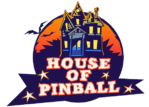Electro-Mechanical (EM) pinball machines represent the rich heritage of classic pinball. These beautifully engineered games rely on intricate mechanical and electrical systems, making troubleshooting a unique challenge. Whether you’re a seasoned technician or a prospective buyer browsing pinball machines for sale, understanding how to diagnose common EM issues builds trust and empowers you to make smart purchases.
At House of Pinball, we want to help you master the art of EM pinball diagnosis using a clear, logical flowchart approach. This step-by-step guide will demystify the most frequent problems, helping you decide what to buy and how to maintain your machine for lasting enjoyment.
What Is an EM Pinball Machine?
Before diving in, it’s important to know what makes an EM pinball machine unique. Unlike modern solid-state machines that rely heavily on microprocessors, EM machines use relays, stepper units, score reels, and switches to control gameplay. This makes them mechanically complex but also wonderfully tactile and rewarding.
However, the reliance on mechanical parts means wear and tear is common, so knowing how to spot and fix issues is key.
Common EM Pinball Issues and Symptoms
Here are some of the most typical EM pinball problems you may encounter:
- Machine won’t start or reset
- Score reels not advancing
- Flippers weak or unresponsive
- Lights flickering or not working
- Ball getting stuck or poor playfield action
- Chime or bell sounds missing
Recognizing symptoms helps you pinpoint where to start your diagnosis.
The Logical Flowchart for Diagnosing EM Pinball Problems
Below is a simplified logical flowchart approach to troubleshooting EM machines:
Step 1: Verify Power and Start-Up
- Is the machine turning on?
- Check power cord, fuse, and switch.
- Measure voltage to the machine.
- Does the machine reset when you press start?
- If no, inspect reset relay and start switch.
Step 2: Check Score Reels and Stepper Units
- Are score reels advancing correctly?
- Observe mechanical movements.
- Look for dirty contacts or worn gears.
- Is the stepper unit advancing?
- Listen for relay clicks.
- Test coil function with a multimeter.
Step 3: Diagnose Flipper Problems
- Are flippers weak or slow?
- Check coil resistance and coil sleeve condition.
- Inspect flipper switches for proper operation.
- Are the flipper mechanisms clean and lubricated?
- Remove debris and apply recommended lubricant.
Step 4: Inspect Lighting and Chime Circuits
- Do the lights turn on consistently?
- Replace burnt-out bulbs and clean sockets.
- Test wiring harness for broken connections.
- Is the chime functioning?
- Check chime coil and switch operation.
Step 5: Evaluate Ball Play and Mechanics
- Does the ball get stuck?
- Inspect playfield for obstructions and wear.
- Check that all switches and relays controlling ball movement are operational.
Why This Flowchart Matters When Buying a Pinball Machine
When considering a pinball machine for sale, especially an EM model, it’s essential to know how to diagnose issues before purchase. This flowchart approach:
- Builds confidence by helping you identify machine health clearly.
- Saves money by pinpointing easy fixes versus costly repairs.
- Increases transparency between sellers and buyers, fostering trust.
- Empowers you to maintain and enjoy your machine long-term.
How House of Pinball Supports EM Pinball Buyers
At House of Pinball, we specialize in EM machines and offer:
- Detailed condition reports highlighting any known issues.
- Pre-sale inspections and repairs ensuring machines are playable.
- Support and guidance in troubleshooting post-purchase.
- Access to rare EM parts to keep your machine running smoothly.
This commitment ensures you buy with confidence and enjoy your classic pinball experience.
Quick Tips for Maintaining Your EM Pinball Machine
- Regularly clean and adjust switches and contacts.
- Lubricate moving parts sparingly with appropriate grease.
- Keep coils and wiring dry and free from corrosion.
- Replace worn coil sleeves to prevent coil burnout.
- Test and replace fuses as needed to avoid electrical damage.
Final Thoughts
EM pinball machines are fascinating mechanical puzzles and pieces of history. With the right approach to diagnosing issues—like our logical flowchart—you can navigate repairs smoothly and find the perfect machine to add to your collection.
If you’re exploring pinball machines for sale, trust House of Pinball to provide transparent listings, expert advice, and dependable machines. Reach out today and let’s find the ideal EM pinball machine for your home or arcade!
Ready to own a classic EM pinball machine?
Explore our selection now at House of Pinball — your trusted source for quality pinball machines for sale.

